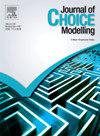A smooth bounded choice model: Formulation and application in three large-scale case studies
IF 2.4
3区 经济学
Q1 ECONOMICS
引用次数: 0
Abstract
One-stage (implicit) choice set formation models offer a computationally efficient way to model how individuals consider alternatives. Among these, the Bounded Choice Model (BCM) stands out for its consistent, utility-based cutoffs. However, the BCM is non-differentiable, which limits its usefulness: key outputs such as elasticities and standard errors cannot be computed analytically. To overcome this, we introduce the Smooth Bounded Choice Model (SBCM). This model assumes a new smooth truncated logistic distribution for the error terms and applies a smooth approximation to the maximum function used in defining the reference utility. As a result, the SBCM is infinitely differentiable, while preserving core features of the BCM, such as bounding, continuity, and the ability to collapse to the Multinomial Logit (MNL) model under specific conditions. Importantly, the SBCM is not just a smoother version of the BCM. Its more flexible distributional assumptions can better capture actual choice behaviour and allow for meaningful differences in predicted probabilities. We derive closed-form expressions for choice probabilities, gradients, Hessians, elasticities, and standard errors, and present a practical estimation method. The SBCM is tested in three case studies: one mode choice and two route choice settings (bicycle and public transport). In all cases, it outperforms both the BCM and MNL in terms of model fit and interpretability. While the BCM has so far been limited to car route choice, we show that the SBCM is widely applicable across various discrete choice contexts.
光滑有界选择模型:在三个大规模案例研究中的表述和应用
单阶段(隐式)选择集形成模型提供了一种计算效率高的方法来模拟个体如何考虑备选方案。其中,有界选择模型(BCM)因其一致的、基于效用的截止点而脱颖而出。然而,BCM是不可微的,这限制了它的实用性:关键输出,如弹性和标准误差不能解析计算。为了克服这个问题,我们引入了平滑有界选择模型(SBCM)。该模型假设误差项为新的平滑截断逻辑分布,并对定义参考效用时使用的最大函数应用平滑近似值。因此,SBCM是无限可微的,同时保留了BCM的核心特征,如边界、连续性和在特定条件下坍缩为多项式Logit (MNL)模型的能力。重要的是,SBCM不仅仅是BCM的平滑版本。它更灵活的分布假设可以更好地捕捉实际的选择行为,并允许在预测概率上有意义的差异。我们推导了选择概率、梯度、黑森、弹性和标准误差的封闭表达式,并提出了一种实用的估计方法。SBCM在三个案例研究中进行了测试:一种模式选择和两种路线选择设置(自行车和公共交通)。在所有情况下,它在模型拟合和可解释性方面都优于BCM和MNL。虽然BCM到目前为止仅限于汽车路线选择,但我们表明SBCM广泛适用于各种离散选择环境。
本文章由计算机程序翻译,如有差异,请以英文原文为准。
求助全文
约1分钟内获得全文
求助全文

 求助内容:
求助内容: 应助结果提醒方式:
应助结果提醒方式:


